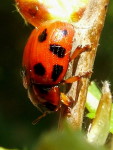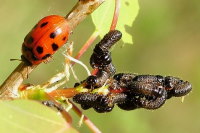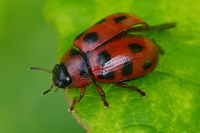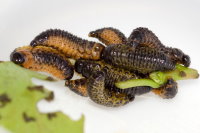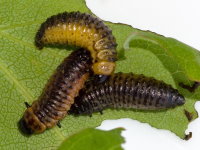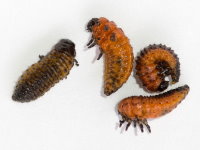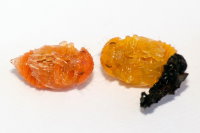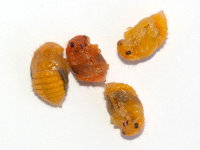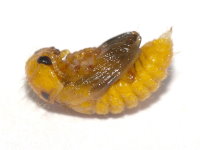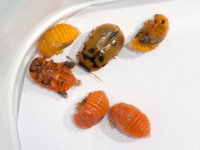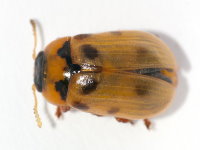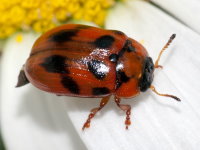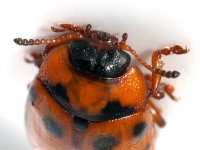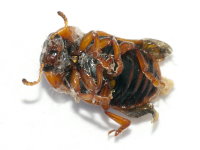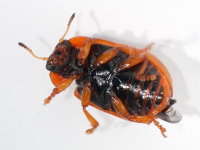Phylum Arthropoda (Arthropods) ➔ Subphylum Hexapoda (Hexapods) ➔ Class Insecta (Insects) ➔ Order Coleoptera (Beetles) ➔ Family Chrysomelidae (Leaf beetles)
Gonioctena (Gonioctena) decemnotata (Marsham, 1802)
Zehnpunkt-Pappelblattkäfer
Synonyms and other combinations:
Chrysomela decemnotata Marsham, 1802 | Chrysomela rufipes De Geer, 1775 nec Linnaeus, 1758 | Chrysomela fulvipes (Duftschmid, 1825) | Chrysomela sexpunctata (Fabricius, 1787) nec Linnaeus, 1758 |
Classification:
Gonioctena decemnotata belongs to the subfamily Chrysomelinae, tribe Gonioctenini.Distribution:
Europe (except Iberian Peninsula and Ireland), east to Mongolia, south to Turkey.Habitat:
Light forests and groves with poplars, preferably in drier places, often in hilly areas.Description:
Length 5.5 - 7.5 mm; variable species; elytra each with 9 regular dotted stripes arranged in rows; scutellum dark brown or black; pronotum slightly arched, usually coarsely dotted on the sides; front part of the head, palpi and antennae reddish, only the last antennal segments slightly darkened; mandibles hollowed out on the sides for insertion of the palpi; legs reddish-yellow or only the tarsi darkened; front tibiae at the tip with a usually well developed tooth.Biology:
The imagines of Gonictena decemnotata are good flyers. They usually appear in May after hibernation.The univoltine species usually lives on poplars (Salicaceae), frequently on aspens (Populus tremula, more rarely on black poplars (Populus nigra). Imagines sometimes also feed on willows (Salix).
The females lay their eggs in groups of about 40 pieces. After a few days the larvae hatch. Further north the females are vivipar, i.e. the larvae hatch already in the female abdomen. The larvae develop in May and June and pass through 4 larval stages. They eat together and live in dense groups guarded by their mother on the leaves of their host plant. After a short time (about 2 weeks) the larvae are fully grown. They drop to the ground and pupate in a burrow. After about 8 days the new generation hatches. The beetles undergo a summer diapause in the foliage layer or on the ground, appear briefly and start looking for winter shelter.
The adults of Gonictena decemnotata are long-lived and often overwinter a second time.
References, further reading, links:
- Rheinheimer, Joachim, & Hassler, Michael: Die Blattkäfer Baden-Württembergs, 2018, 928 pages, Kleinsteuber Books (Karlsruhe), ISBN 978-3-9818110-2-5
- Arved Lompe: Die Käfer Europas - Ein Bestimmungswerk im Internet
- Altica sp.
- Bruchus sp.
- Cassida nebulosa
- Cassida sp.
- Cassida stigmatica
- Cassida vibex
- Cassida vibex/bergeali
- Chrysolina lucidicollis
- Chrysolina oricalcia
- Chrysolina sp.
- Chrysolina sturmi
- Chrysolina varians
- Chrysomela tremula
- Coptocephala sp.
- Crepidodera aurea
- Crepidodera fulvicornis
- Cryptocephalus moraei
- Cryptocephalus nitidus
- Cryptocephalus pusillus
- Cryptocephalus sp.
- Donacia cinerea
- Donacia marginata
- Donacia versicolorea
- Galeruca tanaceti
- Galerucella s.l.
- Gonioctena decemnotata
- Gonioctena quinquepunctata
- Gonioctena sp.
- Gonioctena viminalis
- Lema cyanella
- Neocrepidodera sp.
- Oulema melanopus/duftschmidi
- Oulema obscura
- Pachybrachis sp.
- Phratora sp.
- Plagiosterna aenea
- Plateumaris sp.
- Podagrica fuscicornis
- Psylliodes sp.
- Sphaeroderma sp.
- Gonioctena quinquepunctata/intermedia
- Alder Leaf Beetle
- Ant Bag Beetle
- Barley Flea Beetle
- Brassy Willow Leaf Beetle
- Broad Bean Weevil
- Case-bearing Leaf Beetles
- Colorado Potato Beetle
- Dead-nettle Leaf Beetle
- Elm Leaf Beetle
- Four Spotted Leaf Beetle
- Green Dock Beetle
- Green Tortoise Beetle
- Horseradish Flea Beetle
- Imported Willow Leaf Beetle
- Iris Flea Beetle
- Lily Leaf Beetle
- Plantain Leaf Beetle
- Poplar Leaf Beetle
- Skullcap Leaf Beetle
- Spotted Asparagus Beetle
- Spotted Willow Leaf Beetle
- St John's-wort Leaf Beetle
- Thistle Tortoise Beetle
- Turnip Flea Beetle
- Two-tone Reed Beetle
- Viburnum Leaf Beetle
- Western Grape Rootworm
- Wheat Flea Beetle
- Willow Flea Beetle
- Willow Leaf Beetle
